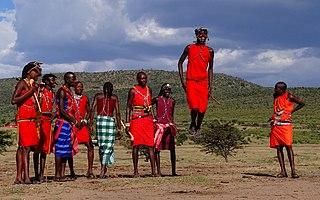
Eldoret is the fifth largest city in Kenya. It is located in the Rift Valley region and serves as the capital of Uasin Gishu County. The town was referred to by white settlers as Farm 64 and colloquially by locals as 'Sisibo'. As per the 2019 Kenya Population and Housing Census, Eldoret is the fifth most populated urban area in the country after Nairobi, Mombasa, Nakuru and Ruiru. Lying south of the Cherangani Hills, the local elevation varies from about 2,100 metres (6,900 ft) at the airport to more than 2,700 metres (8,900 ft) in nearby areas. The population was 289,380 in the 2009 Census, and it is currently the fastest growing town in Kenya with 475,716 people according to 2019 National Census. Eldoret was on course to be named Kenya's fourth city, but was edged out by Nakuru in 2021.

The Kalenjin are a group of tribes indigenous to East Africa, residing mainly in what was formerly the Rift Valley Province in Kenya and the Eastern slopes of Mount Elgon in Uganda. They number 6,358,113 individuals per the Kenyan 2019 census and an estimated 273,839 in Uganda according to the 2014 census mainly in Kapchorwa, Kween and Bukwo districts.

Uasin Gishu County is one of the 47 counties of Kenya located in the former Rift Valley Province. Eldoret has the county's largest population centre as well as its administrative and commercial centre. “It lies between longitudes 34 degrees 50’ east and 35 degrees 37’ West and latitudes 0 degrees 03’ South and 0 degrees 55’ North. It is a highland plateau with altitudes falling gently from 2,700 meters above sea level to about 1,500 meters above sea level. The topography is higher to the east and declines gently towards the western border”.

The Nandi are part of the Kalenjin, a Nilotic tribe living in East Africa. The Nandi ethnic group live with close association and relation with the Kipsigis tribe. They traditionally have lived and still form the majority in the highland areas of the former Rift Valley Province of Kenya, in what is today Nandi County. They speak the Nandi dialect of the Kalenjin language.
Kimnyole Arap Turkat was the Nandi Orkoiyot who predicted the arrival of Europeans and the railways ; two events that were to forever alter the history of the Nandi.
Nandi Hills is a town and also an electoral constituency in Kenya's Nandi County.The name also refers to the general area of Nandi County, where the urban settlement is located. Its current Member of Parliament is Hon. Bernard Kibor Kitur of United Democratic Alliance (UDA) party.

The Elgeyo are an ethnic group who are part of the larger Kalenjin ethnic group of Nilotic origin. They live near Eldoret, Kenya, in the highlands of the former Keiyo District, now part of the larger Elgeyo Marakwet County. The Elgeyo originally settled at the foothills of the Elgeyo escarpment, in the area between Kerio river to the east and the escarpment to the west. Due to drought and famine in the valley, the Keiyos climbed the escarpment and started to settle on the highland east of Uasin Gishu plateau. When the British came, the Keiyos were pushed to settle in clusters called reserves.
Kapsabet is a town in Kenya. It is the capital of Nandi County and is located 40 kilometres southwest of Eldoret on the way to Chavakali.
Kaptagat is a human settlement in Uasin Gishu County, in the southwestern part of Kenya. This part of the country, where the two counties of Uasin Gishu and Elgeyo Marakwet County share a border, is used by the majority of Kenyan professional long-distance runners to train for professional competition. Eliud Kipchoge, the former marathon world record holder, who also doubles as the Tokyo Olympics and Rio Olympics marathon gold medalist, maintains a training camp in Kaptagat.
Koitalel arap Samoei was an Orkoiyot who led the Nandi people from 1890 until his assassination in 1905. The Orkoiyot occupied a sacred and special role within the Nandi and Kipsigis people of Kenya. He held the dual roles of chief spiritual and military leader, and had the authority to make decisions regarding security matters particularly the waging of war and negotiating for peace. Koitalel was the supreme chief of the Nandi people of Kenya. He led the Nandi resistance against British colonial rule.

Jean-Marie Seroney was a Kenyan human rights advocate, a legislator, and an Amnesty International prisoner of conscience. He was detained as a prisoner of conscience for 1,155 days.
Nandi District was an administrative district in the Rift Valley Province of Kenya. Its capital town was Kapsabet.
The Nandi Resistance was a military conflict that took place in present-day Kenya between 1890 and 1906. It involved members of the Kalenjin ethnic group, mainly from the Nandi section, and the British colonial administration. The close of the 19th century, a time referred to as the "pacification period" by Matson, saw a number of local populations that resisted British colonial rule. Of these, the Nandi resistance would stand out for being the longest and most tenacious.

Paul Kiplimo Boit was a prominent KANU politician during the Moi Regime. He was the Chairman of Sirikwa County Council (which later came to be divided to Nandi County, Uasin Gishu County, Trans Nzoia County, West Pokot County Elgeyo Marakwet County from 1964 to 1971 and later became the Chairman of Wareng County Council one of five Councils split from Sirikwa covering Uasin Gishu. He was best known for his excellent farming skills which earned him many awards and a visit from the former Tanzanian president Ali Hassan Mwinyi
A bororiet was a kind of geographic division of the traditional society of the Nandi people of Kenya. It had military and political functions in addition to the territorial element. Each bororiet was made up of kokwotinwek which were groups of homesteads within the same locality, roughly equal to a hamlet but smaller than a village. The bororosiek were, in turn, grouped into emet but these were only of territorial significance.

The Oreet is a kinship group among the Kalenjin people of Kenya that is similar in concept to a clan. The members of an oreet were not necessarily related by blood as evidenced by the adoption of members of the Uasin Gishu Maasai by Arap Sutek, the only Nandi smith at the time. His proteges would later be adopted into almost every other clan as smiths. More famously, the lineage of the Talai Orkoiik were adopted members of the Segelai Maasai.
Barsirian Arap Manyei was the last widely recognized Nandi Orkoiyot and Kenya's longest serving political detainee.
The Settlement of Nandi was the historical process by which the various communities that today make up the Nandi people of Kenya settled in Nandi County. It is captured in the folklore of the Nandi as a distinct process composed of a series of inward migrations by members from various Kalenjin ortinwek.
The Uasin Gishu people were a community that inhabited a plateau located in western Kenya that today bears their name. They are said to have arisen from the scattering of the Kwavi by the Maasai in the 1830s. They were one of two significant sections of that community that stayed together. The other being the Laikipiak with whom they would later ally against the Maasai.
The Siger people were a community commonly spoken of in the folklore of a number of Kenyan communities that inhabited regions of northwestern Kenya at various points in history.













